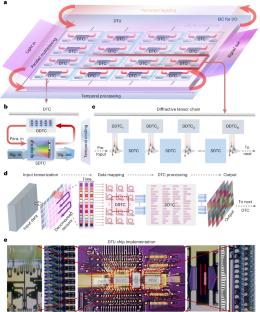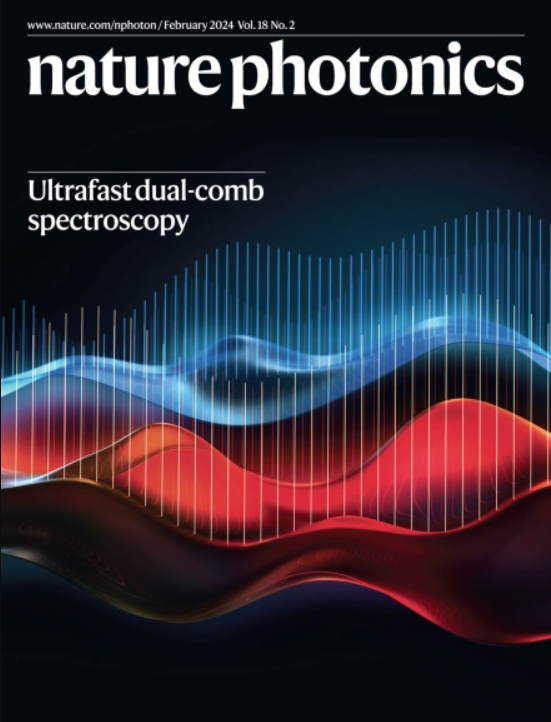Diffractive tensorized unit for million-TOPS general-purpose computing
IF 32.9
1区 物理与天体物理
Q1 OPTICS
引用次数: 0
Abstract
Photonic computing has emerged as a promising next-generation technology for processors, with diffraction-based architectures showing particular potential for large-scale parallel processing. Unfortunately, the lack of on-chip reconfigurability poses significant obstacles to realizing general-purpose computing, restricting the adaptability of these architectures to diverse advanced applications. Here we propose a diffractive tensorized unit (DTU), which is a fully reconfigurable photonic processor supporting million-TOPS general-purpose computing. The DTU leverages a tensor factorization approach to perform complex matrix multiplication through clustered diffractive tensor cores, while each diffractive tensor core employs a near-core modulation mechanism to activate dynamic temporal diffractive connections. Experiments confirm that the DTU overcomes the long-standing generality and scalability constraints of diffractive computing, realizing general computing with a 10−6 mean absolute error for arbitrary 1,024-size matrix multiplications. Compared with state-of-the-art solutions, the DTU not only achieves competitive accuracy on various challenging tasks, such as natural language generation and cross-modal recognition, but also delivers a 1,000× improvement in computing throughput over conventional electronic processors. The proposed DTU represents a leap forward in general-purpose photonic computing, paving the way for further advancements in large-scale artificial intelligence. A photonic processor based on a diffractive tensorized unit enables million-TOPS general-purpose computing. The approach challenges the generality and scalability constraints of diffractive computing and enables orders-of-magnitude improvements in energy efficiency over a high-end electronic tensor core processor.


用于百万tops通用计算的衍射张化单元
光子计算已经成为下一代处理器的一种有前途的技术,基于衍射的架构显示出大规模并行处理的特殊潜力。不幸的是,缺乏片上可重构性对实现通用计算构成了重大障碍,限制了这些体系结构对各种高级应用的适应性。在这里,我们提出了一个衍射张化单元(DTU),这是一个完全可重构的光子处理器,支持百万tops通用计算。DTU利用张量分解方法通过聚集的衍射张量核执行复杂矩阵乘法,而每个衍射张量核采用近核调制机制来激活动态时间衍射连接。实验证实,DTU克服了衍射计算长期存在的通用性和可扩展性限制,实现了任意1024大小矩阵乘法的平均绝对误差为10−6的通用计算。与最先进的解决方案相比,DTU不仅在各种具有挑战性的任务(如自然语言生成和跨模态识别)上实现了具有竞争力的准确性,而且在计算吞吐量方面也比传统电子处理器提高了1000倍。提出的DTU代表了通用光子计算的飞跃,为大规模人工智能的进一步发展铺平了道路。
本文章由计算机程序翻译,如有差异,请以英文原文为准。
求助全文
约1分钟内获得全文
求助全文
来源期刊

Nature Photonics
物理-光学
CiteScore
54.20
自引率
1.70%
发文量
158
审稿时长
12 months
期刊介绍:
Nature Photonics is a monthly journal dedicated to the scientific study and application of light, known as Photonics. It publishes top-quality, peer-reviewed research across all areas of light generation, manipulation, and detection.
The journal encompasses research into the fundamental properties of light and its interactions with matter, as well as the latest developments in optoelectronic devices and emerging photonics applications. Topics covered include lasers, LEDs, imaging, detectors, optoelectronic devices, quantum optics, biophotonics, optical data storage, spectroscopy, fiber optics, solar energy, displays, terahertz technology, nonlinear optics, plasmonics, nanophotonics, and X-rays.
In addition to research papers and review articles summarizing scientific findings in optoelectronics, Nature Photonics also features News and Views pieces and research highlights. It uniquely includes articles on the business aspects of the industry, such as technology commercialization and market analysis, offering a comprehensive perspective on the field.
 求助内容:
求助内容: 应助结果提醒方式:
应助结果提醒方式:


